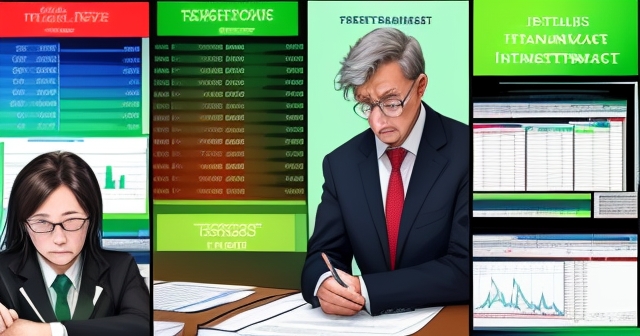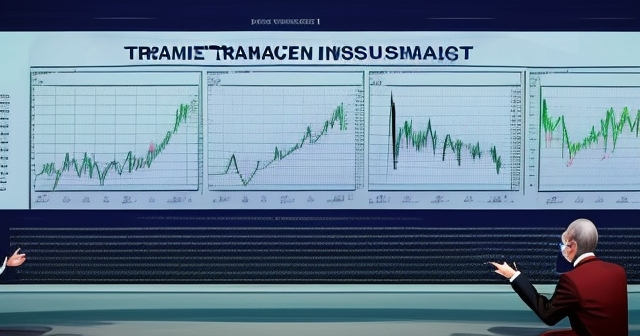Navigating the Current Equity Market: A Deep Dive into Volatility, Tariffs, and Macro Headwinds
Global financial markets are currently experiencing a significant period of turbulence. Major stock indices, both in the U.S. and internationally, have seen sharp declines, leaving many investors wondering what is driving this
selloff
and what lies ahead. If you’re an investor, whether new to the scene or a seasoned technical analyst, understanding the forces at play is crucial for navigating these choppy waters.
In this article, we’re going to take a deep dive into the key factors influencing the
stock market
right now. We’ll look at recent performance, the impact of political decisions like tariffs, the persistent challenge of inflation, and what economic indicators like recession fears might mean for your
investing
strategy
. We’ll aim to break down complex ideas into understandable concepts, much like building a trading plan piece by piece. So, let’s get started on understanding this intricate
markets
landscape together.
Here are some key factors to consider:
- Market Volatility: Understanding how volatility affects investor sentiment and market dynamics is critical.
- Economic Indicators: Keeping track of inflation, tariffs, and recession fears will significantly influence your investment decisions.
- Corporate Performance: Corporate earnings and sector-specific events can impact stock prices directly.

Understanding the Recent Market Selloff: Indices and Investor Sentiment
Let’s begin by looking at the raw data of market performance. Recent reports from sources like Reuters and Yahoo Finance have highlighted considerable pressure on major U.S.
indices
. We’ve seen significant
declines
in the
Dow Jones
Industrial Average (
DJIA
), the
S&P 500
, and the
NASDAQ Composite
. Even the smaller cap focused
Russell 2000
has felt the pinch.
What do these
indices
tell us? The
DJIA
represents 30 large, publicly traded companies in the U.S. The
S&P 500
is broader, tracking 500 of the largest U.S. companies and is often considered the best single gauge of large-cap U.S.
stock market
performance. The
NASDAQ Composite
is heavily weighted towards technology and growth
stocks
. When all these move down together, it signals a broad loss of confidence or significant systemic pressure affecting different types of companies across the economy.
Furthermore,
futures
markets have indicated that this negative momentum could continue.
Stock
futures
are agreements to buy or sell a specific
stock index
or individual
stock
at a predetermined price at a future date. Their movement after regular
trading
hours often provides a preview of how the
market
might open the next day. When
futures
show further
plunges
, it reflects
investors
‘ expectations of ongoing
selloffs
or negative news on the horizon.
Another crucial indicator is the
VIX
, often called the “fear index.” The
VIX
measures expected
stock market
volatility
based on
S&P 500
options. When the
VIX
is up significantly, as recent data suggests, it indicates that
investors
are anticipating larger price swings in the near future. Higher
volatility
often correlates with market uncertainty and
downturns
.
Why is understanding this index performance important for you? Because it provides the backdrop against which all other news and analysis should be viewed. These numbers aren’t just statistics; they represent the collective sentiment and positioning of millions of
investors
reacting to the economic and political environment. They are the fingerprints left by the forces we are about to discuss.
| Index | Significance | Latest Performance |
|---|---|---|
| DJIA | Tracks 30 large companies | Significant decline noted |
| S&P 500 | Broad measure of large-cap stocks | Consistent drop observed |
| NASDAQ | Heavily weighted toward tech stocks | Falling sharply |
The Tariff Threat: How Policy Decisions Cause Market Carnage
Perhaps the most frequently cited reason for the recent market
carnage
is the increasing concern over
tariffs
and trade tensions. Policy decisions, particularly those signaled by former President Trump, are casting a long shadow over global markets. Reports suggest these proposed
tariffs
are seen as a primary cause for recent
market
selloffs
.
Tariffs
are essentially taxes on imported goods. While they are intended to protect domestic industries, they can have wide-ranging negative consequences for the economy and, subsequently, the
stock market
.
- Increased Costs:
Tariffs
make imported goods more expensive. For businesses that rely on imported raw materials or components, this increases their operating costs, which can hurt their profitability and stock prices.
- Reduced Demand: Higher prices for imported goods can reduce consumer demand, impacting sales for companies that sell those goods.
- Retaliation: Other countries often respond to
tariffs
with their own
tariffs
on exports from the initiating country. This hurts companies that sell products internationally, reducing their overseas
earnings
.
- Supply Chain Disruption: Businesses may need to find new suppliers if imports become too expensive or restricted, leading to inefficiencies and disruptions in their supply chains.
- Uncertainty: The threat of future
tariffs
creates uncertainty for businesses and
investors
. This makes it harder to plan for the future, often leading to reduced investment and hiring, and causing
investors
to become more cautious or fearful, driving
selloffs
.
Warnings from prominent figures underscore the severity of these concerns. Bill Ackman, for instance, has reportedly linked
tariffs
to the potential for an “economic nuclear winter.” This dramatic phrase highlights the fear that cascading trade restrictions could severely damage global trade and economic growth, with devastating effects on financial markets worldwide.
Consider the impact on specific sectors or companies. Reports mentioned concerns about potential auto
tariffs
. This would directly affect major automakers and companies in their supply chains. Similarly, companies like
Tesla
and
Apple
have reportedly seen
price targets
cut by analysts, partly due to the potential fallout from
tariffs
impacting their global sales or production costs.
The “Liberation Day” announcement reference also points to a potential future date where significant policy changes regarding trade or other economic matters could be unveiled, adding another layer of uncertainty that keeps
markets
on edge. For us as
investors
or traders, this means closely monitoring policy developments and understanding which companies and sectors are most exposed to these trade risks.

Inflation’s Persistent Grip: Dimming Hopes for Rate Cuts
Beyond the political realm of
tariffs
, macroeconomic factors are also playing a significant role.
Inflation
remains a key concern, acting like a silent tax that erodes the purchasing power of money. The “hotter January
inflation
” report mentioned in the data refers to the Consumer Price Index (
CPI
) or Personal Consumption Expenditures (
PCE
) data exceeding expectations for that month. While specific to January, this indicates that the battle against rising prices isn’t over, and
inflationary
pressures might be more persistent than hoped.
Why does
inflation
spook the
stock market
?
- Reduced Profit Margins: Companies face higher costs for materials, labor, and energy. While they may try to pass these costs onto consumers, they often can’t do so entirely, squeezing profit margins.
- Lower Valuation Multiples:
Inflation
reduces the present value of future
earnings
. When
inflation
is high, the purchasing power of future profits is worth less today, leading
investors
to pay lower multiples (like Price-to-
Earnings
ratios) for
stocks
.
- Central Bank Response: This is perhaps the most direct link to recent
market
reactions. Central banks, like the
Federal Reserve
(
Fed
) in the U.S., use interest rates as their primary tool to combat
inflation
. When
inflation
remains stubbornly high, it increases the likelihood that the
Fed
will keep
interest rates
higher for longer, or even raise them further.
The “hotter January
inflation
” report reportedly “jolted markets” and “dimmed hopes for earlier
Fed
rate cuts
.” Higher
interest rates
make borrowing more expensive for businesses, which can slow down expansion and reduce profitability. They also make bonds and other fixed-income investments relatively more attractive compared to
stocks
, potentially pulling money out of the
equity market
.
Current expectations, according to some reports, are that the
Fed
will hold
rates
until September, although “some bets on an earlier cut exist.” This uncertainty about the timing and magnitude of potential
rate cuts
adds another layer of
volatility
to the
markets
.
Investors
are closely watching every piece of economic data and every statement from
Fed
officials like Jerome Powell for clues about the future path of monetary policy.
The interaction between
tariffs
and
inflation
is also complex.
Tariffs
directly contribute to
inflation
by making imported goods more expensive. This creates a difficult scenario for the
Fed
, as it tries to control
inflation
driven partly by factors outside its direct control (trade policy).

Recession Fears and Economic Outlook: Reading the Early Warning Signs
When concerns about
tariffs
disrupting trade and
inflation
leading to tighter monetary policy combine, the specter of a recession often emerges. A
recession
is a significant decline in economic activity, typically spread across the economy and lasting more than a few months.
Recession
fears are linked to both
inflation
(which can reduce consumer spending) and
tariffs
(which can hurt business investment and trade). How can
investors
look for potential early warning signs?
- Corporate Earnings: Reports suggested that big banks’
earnings
could be potential early indicators. Why banks? Because they are central to the economy’s financial plumbing. Their
earnings
reports provide insights into lending activity, loan defaults, and overall business health. A significant downturn in bank profitability can signal broader economic weakness.
- Consumer Confidence: Mentioned in the data is a loss of confidence among young Americans. Consumer spending is a major driver of the U.S. economy. If consumers, especially younger ones, lose confidence in their financial future, they tend to reduce spending, which can slow down economic growth.
- Services Activity: While not explicitly detailed in the summary, broader economic indicators like purchasing managers’ indices (PMI) for manufacturing and services are closely watched. A slowdown in the services sector, which is a large part of developed economies, can be a strong signal of weakening economic activity.
The
Bank of Canada
, according to the data, has warned that a protracted U.S. trade war could cause a “permanent hit to Canada’s GDP level.” This highlights how trade policy in one major economy can have significant, lasting impacts on its trading partners, contributing to global
recession
fears.
For you as an
investor
, tracking these indicators is vital. A potential
recession
typically leads to lower corporate
earnings
, which in turn pressures
stock prices
. Companies that are highly sensitive to economic cycles (cyclical
stocks
) are particularly vulnerable during a
downturn
.

Corporate News and Stock-Specific Events Amidst Macro Uncertainty
While macro factors set the overall tone for the
markets
, individual corporate news and events continue to influence specific
stocks
and sectors. Even in a volatile market, company-specific developments can drive significant price movements.
Let’s look at some examples from the provided data:
- IPOs and Market Skepticism: The debut of
CoreWeave
, described as the biggest tech
IPO
in years, is a key event. An
IPO
(Initial Public Offering) is when a private company first offers shares of
stock
to the public. A successful
IPO
can signal strong
investor
appetite, particularly for growth companies. However, reports note that
CoreWeave
‘s debut is happening amidst broader
market
skepticism. This means that even a highly anticipated
IPO
faces challenges in a fearful
market
. Its success (or lack thereof) can influence the pipeline of future
IPOs
and impact investment banks like
Goldman Sachs
, which are involved in bringing companies to the public
market
. The
CoreWeave
CEO’s discussion of the company’s debt strategy is also relevant, as debt levels are scrutinized by
investors
, especially in uncertain times.
- M&A and Valuation: Elon Musk’s
xAI
acquiring
X
and valuing the social media site at
$33 billion
is a notable M&A (Mergers and Acquisitions) event. M&A activity reflects corporate confidence and strategic shifts. The
valuation
placed on
X
in this deal provides insight into how privately held tech assets are being appraised, even as public tech
stocks
face pressure.
- Stock-Specific Challenges:
Tesla
and
Apple
seeing
price targets
cut by analysts highlights how major companies are not immune to macro pressures. For
Tesla
, reasons cited included “deliveries pressure” and “tariff fallout.” For
Apple
, it was also linked to “tariff fallout.” Analyst
price targets
are forecasts for a
stock
‘s future price, based on the analyst’s research and models. Cuts to these targets can influence
investor
sentiment and contribute to
stock price declines
.
- Relative Strength: On a more positive note,
Dollar General
was mentioned as potentially a “buy” because consumers might be “trading down” to discount retailers during economic uncertainty. This illustrates how different companies perform differently depending on the economic environment. Analyzing consumer behavior and its impact on specific business models is a key part of
stock
analysis.
Texas Roadhouse
and
Sportradar
were also mentioned, suggesting ongoing analysis of various companies’ performance and
outlook
.
- Addressing Market Speculation: The
AppLovin
CEO responding to short-seller reports is another common corporate event. Short sellers bet on a
stock
‘s price going down, often publishing research reports detailing why they believe the
stock
is overvalued or the company faces significant problems. A CEO’s response is an attempt to defend the company and its
stock
price against such claims.
These examples show that even when the overall
market
is turbulent, conducting thorough research on individual companies and understanding their specific drivers and challenges remains essential for making informed
investing
decisions.
Politics and Regulation: Influences Beyond Macroeconomics
Beyond trade
tariffs
, political actions and regulatory changes also ripple through the financial
markets
. Government policy and regulatory bodies can significantly impact industries, corporate behavior, and
investor
confidence.
Some examples from the data illustrate this point:
- Executive Actions: Former President Trump’s use of commutation and pardon power, such as for
Carlos Watson
(
Ozy Media
) and the
BitMEX
founders (involved in a money laundering case), can be relevant to the financial world, particularly for those involved in white-collar crime or the crypto space. While not directly moving
stock prices
for most public companies, such actions reflect the political environment and potential approaches to regulating certain industries or activities. His reported plans for
HHS
job cuts or promises of tax cuts to CEOs also signal potential future policy directions that could affect specific sectors or the broader economy.
- Regulatory Body Actions: A judge ordering the
CFPB
(Consumer Financial Protection Bureau) to reinstate fired employees or the
FCC
(Federal Communications Commission) investigating
Disney
/
ABC
over
DEI efforts
show how regulatory bodies are active and can impact company operations or finances. The
CFPB
deals with financial consumer protection, affecting banks and financial services. The
FCC
regulates communications, impacting media companies like
Disney
. Regulatory investigations or mandates can create legal costs, fines, or force changes in business practices, all of which can affect a company’s bottom line and
stock price
.
- Leadership Appointments: President Biden nominating
Christy Goldsmith Romero
to lead the
FDIC
(Federal Deposit Insurance Corporation) is important because the
FDIC
plays a critical role in maintaining stability in the U.S. banking system. Leadership at such key regulatory bodies influences policy direction and oversight for the financial industry.
- Sanctions:
US sanctions
forcing the end of dollar/euro
trading
on Russia’s main exchange highlights how geopolitical actions directly impact currency
markets
and international financial flows. While this isn’t directly about
equity trading
on Wall Street, it affects the global financial system and can have knock-on effects, such as impacting companies with exposure to Russia or influencing currency exchange rates, which in turn affect the international
earnings
of multinational corporations.
These political and regulatory factors add complexity to the
investing
environment. They demonstrate that successful
investing
isn’t just about analyzing balance sheets or technical charts; it also requires awareness of the broader political and regulatory landscape.

Investment Strategies in a Volatile Market: What Approaches Work Now?
Given the current environment of
volatility
,
selloffs
, and uncertainty, many
investors
are asking: What’s the right
strategy
? There’s no single answer that fits everyone, but understanding different approaches can help you decide what might work for your
portfolio
and risk tolerance.
The data touches on several strategies and considerations:
- Buying the Dip: This involves purchasing
stocks
after they have experienced a significant
decline
, with the expectation that the price will rebound. The question is often posed: Is now the time to “buy the
dip
” in tech? This
strategy
requires conviction that the underlying reasons for the
selloff
are temporary and that the long-term
outlook
remains strong. However, it carries the risk that the market may continue to fall further before recovering, if it recovers at all in the short term.
- Value Investing:
Joel Greenblatt
‘s view on value
investing
being a defense suggests focusing on
stocks
that appear to be
trading
below their intrinsic value, regardless of broader
market
sentiment. Value
stocks
are often less volatile than growth
stocks
and can offer a margin of safety. In a turbulent market, focusing on fundamentals and
valuation
can be a powerful
strategy
.
- Dividend Stocks: Mentioned as a
strategy
for “longevity,”
dividend stocks
are shares in companies that regularly distribute a portion of their
earnings
to shareholders in the form of dividends. These
stocks
are often from more established, stable companies. Dividends can provide a stream of income that can cushion
portfolio
returns during
market downturns
and offer some stability.
- Technical Analysis:
Carter Worth
‘s analysis of charts for Treasury prices highlights the role of technical analysis – studying price charts and patterns to forecast future
market
movements. While the example is about bonds, the principles apply equally to
equity trading
. Technical
traders
look for signals like support and resistance levels,
trading
volumes, and chart formations to identify potential entry and exit points. This approach can be particularly useful for timing
trades
during periods of high
volatility
.
Other considerations mentioned include understanding “smart money moves” during
market downturns
(often professional
investors
making strategic adjustments), managing your 401(k) during crashes (important for long-term retirement
investors
), and even the impact of personal finance issues like late student loan payments on credit scores, which can affect an individual’s ability to access credit for
investing
or other purposes.
Choosing the right
strategy
depends on your financial goals, time horizon, risk tolerance, and how much time you can dedicate to
research
and
trading
. Diversification across different asset classes and sectors is also generally recommended to manage risk.
| Strategy | Description | Potential Risks |
|---|---|---|
| Buying the Dip | Purchasing stocks after significant declines with the expectation of recovery. | Market may continue to decline further. |
| Value Investing | Focusing on stocks trading below their intrinsic value. | Market sentiment can remain negative for extended periods. |
| Dividend Stocks | Investing in stocks that pay regular dividends. | Dependence on company performance for dividends. |
| Technical Analysis | Using charts and technical indicators to guide trading decisions. | Market volatility may lead to misleading signals. |
Broader Market Context: Global Spillovers and Other Asset Classes
No
market
exists in isolation. The pressures facing U.S. equities are part of a larger global financial picture. Understanding how other
markets
and asset classes are reacting can provide a more complete
outlook
.
- Global Equity Markets: The data mentioned
declines
in European
markets
(
FTSE
,
Nikkei
in some reports) and highlighted the potential impact on
Canada’s GDP
from a U.S. trade war. This demonstrates that the concerns about
tariffs
and economic slowdown are not confined to the United States; they are global anxieties affecting indices across continents. The fear of a potential “financial crisis in France” linked to political shifts there also shows how local political events in major economies can trigger broader regional
market
instability.
- Currencies: The
US Dollar
(
USD
) dominance has reportedly been under pressure. The
dollar’s
value is influenced by interest rates, economic growth
outlook
, and safe-haven demand. Changes in the
dollar’s
strength impact multinational corporations’
earnings
(as foreign profits are translated back into USD) and can affect the competitiveness of U.S. exports. The situation with
sanctions forcing an end to USD/EUR trading
on Russia’s main exchange is a stark example of how geopolitical events can directly interfere with currency
markets
and international financial transactions, highlighting the interconnectedness and potential fragility of the global system.
- Other Assets:
Bitcoin
falling amid the
market
swoon
suggests that even alternative assets like cryptocurrencies are not entirely uncorrelated from broader risk-off sentiment affecting traditional
markets
. While often seen as independent, crypto prices can still react to major shifts in liquidity,
investor
confidence, and regulatory news. Commodities like oil and gold (not explicitly detailed in the summary but relevant) also play a role – oil prices affect energy
stocks
and inflation, while gold is often seen as a safe-haven asset during times of uncertainty. Bond
markets
are crucial too; changes in Treasury prices (as mentioned in the
Carter Worth
example) reflect movements in interest rates and
investor
demand for government debt, which competes with
stocks
for capital.
Watching these other
markets
provides valuable context. For instance, if bonds are rallying (prices going up, yields going down), it might signal
investors
are seeking safety away from
stocks
. If commodity prices are falling, it could point to expectations of slowing economic growth. This holistic view is important for any serious
investor
or trader.
Looking Ahead: What to Watch for and Potential Scenarios
Given the current
outlook
, what should
investors
and
traders
be watching for in the coming weeks and months?
- Trade Policy Developments: Any clarity or further announcements regarding
tariffs
, especially potential auto
tariffs
or a potential “Liberation Day” policy unveiling, will be critical. A de-escalation of trade tensions could provide a significant boost to sentiment, while further threats could deepen the
selloff
.
- Inflation Data: Upcoming
CPI
and
PCE
reports will be closely scrutinized to see if
inflationary
pressures are easing or persisting.
- Federal Reserve Communications: Statements and speeches from
Fed
officials, as well as the minutes from
Fed
meetings, will provide clues about their assessment of the economy and the likely timing of potential
rate cuts
.
- Corporate Earnings Reports: As earnings season continues or the next one approaches, paying attention to company
earnings
, revenue growth, and forward-looking guidance will be essential for understanding the health of the corporate sector amidst these headwinds. Watch especially for comments from management on the impact of
tariffs
,
inflation
, and consumer demand.
- Economic Indicators: Continue to monitor data releases on GDP growth, employment, retail sales, and manufacturing/services activity for signs of economic strength or weakness.
- Geopolitical Events: Developments related to
sanctions
, international conflicts, and political stability in major regions can also impact
markets
and currency flows.
Potential scenarios for the
market
could include:
- Continued Volatility: The most likely near-term scenario, with
markets
reacting sharply to incoming data and political news.
- Further Selloff: If
tariff
threats materialize,
inflation
remains high, and
recession
fears intensify,
markets
could see significant further
declines
.
- Stabilization or Recovery: If trade tensions ease,
inflation
shows clear signs of cooling, and the
Fed
signals a clearer path to
rate cuts
(without simultaneously signaling a weak economy),
markets
could find a bottom and begin to recover. This would likely be supported by strong corporate performance in specific sectors.
Conclusion: Navigating the Complexities with Knowledge and Strategy
The current state of the
equity market
is undeniably complex, driven by a confluence of powerful forces.
Tariff
threats are creating significant political risk, while persistent
inflation
is keeping pressure on central banks to maintain tighter monetary policies. These factors collectively fuel
recession
fears and contribute to the heightened
volatility
we are witnessing across global
markets
.
We’ve seen how these macro pressures interact with corporate-specific events like
IPOs
,
earnings reports
, and analyst ratings, impacting individual
stocks
like
Tesla
and
Apple
. We’ve also touched on the broader market context, including how other asset classes like currencies and cryptocurrencies react, and how regulatory actions can influence the financial landscape.
For you, whether you are just starting your
investing
journey or are a seasoned
trader
honing your technical skills, the key takeaway is the importance of knowledge and adaptation. The
markets
are not static, and your
strategy
shouldn’t be either. Stay informed about the key drivers –
tariffs
,
inflation
,
Fed
policy, and economic data. Understand how these factors impact different sectors and individual companies.
Consider different investment approaches that may be suited for a
volatile market
, such as value
investing
or focusing on
dividend stocks
, or how technical analysis can help you time your
trades
. Critically, practice sound risk management to protect your capital from unexpected
downturns
.
Navigating this environment requires patience, discipline, and a commitment to continuous learning. By understanding the forces shaping the
markets
and developing a robust
strategy
that aligns with your goals and risk tolerance, you can position yourself to navigate the current turbulence and work towards achieving your financial objectives. The
market
may be unpredictable, but being well-informed and prepared is your best defense.
equity tradingFAQ
Q:What is causing the current volatility in the equity markets?
A:The volatility is driven by factors including rising inflation, tariff threats, and recession fears impacting investor sentiment.
Q:How do tariffs affect stock prices?
A:Tariffs can increase costs for companies, lead to reduced demand for goods, and create uncertainty, all of which can negatively impact stock prices.
Q:What strategies should investors consider during a volatile market?
A:Investors might consider strategies such as buying the dip, value investing, and focusing on dividend stocks to navigate volatility effectively.

留言